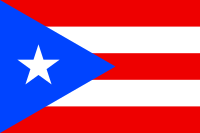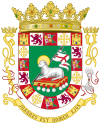The following outline is provided as an overview of and topical guide to Puerto Rico:

The Commonwealth of Puerto Rico is a self-governing unincorporated territory of the United States of America located in the northeastern Caribbean, east of the Dominican Republic and west of the Virgin Islands.[1] The commonwealth comprises an archipelago that includes the main island of Puerto Rico and a number of smaller islands and keys, the largest of which are Vieques, Culebra, and Mona. The main island of Puerto Rico is the least extensive but the third most populous of the four Greater Antilles: Cuba, Hispaniola, Jamaica, and Puerto Rico.
Puerto Ricans often call the island Borinquen, from Borikén, its indigenous Taíno name.[2][3] The terms boricua and borincano derive from Borikén and Borinquen respectively, and are commonly used to identify someone of Puerto Rican heritage. The island is also popularly known as "La Isla del Encanto", which translated means "The Island of Enchantment."
General reference
edit- Pronunciation:
- Common English country name: Puerto Rico
- Official English country name: The Commonwealth of Puerto Rico
- Common endonym(s):
- Official endonym(s):
- Adjectival(s): Puerto Rican
- Demonym(s):
- Etymology: Name of Puerto Rico
- ISO country codes: PR, PRI, 630
- ISO region codes: See ISO 3166-2:PR
- Internet country code top-level domain: .pr
Geography of Puerto Rico
edit- Puerto Rico is
- an archipelagic island country (see also List of island countries)
- a self-governing unincorporated territory of the United States
- organized as a commonwealth
- Location:
- Northern Hemisphere and Western Hemisphere
- North America (though not on the mainland)
- Atlantic Ocean
- North Atlantic
- Caribbean
- Antilles
- Greater Antilles
- Time zone: Eastern Caribbean Time (UTC-04)
- Extreme points of Puerto Rico
- High: Cerro de Punta 1,338 m (4,390 ft)
- Low: Caribbean Sea 0 m
- Land boundaries: none
- Coastline: 501 km
- Population of Puerto Rico: 3,285,874 – 31st most populous US jurisdiction
- Area of Puerto Rico: 9,104 km2
- Atlas of Puerto Rico
Environment of Puerto Rico
editNatural geographic features of Puerto Rico
editRegions of Puerto Rico
editEcoregions of Puerto Rico
editList of ecoregions in Puerto Rico
Administrative divisions of Puerto Rico
editAdministrative divisions of Puerto Rico
Municipalities of Puerto Rico
edit- Capital of Puerto Rico: San Juan
- Cities of Puerto Rico
Demography of Puerto Rico
editGovernment and politics of Puerto Rico
editBranches of the government of Puerto Rico
editExecutive branch of the government of Puerto Rico
editLegislative branch of the government of Puerto Rico
editJudicial branch of the government of Puerto Rico
editForeign relations of Puerto Rico
editForeign relations of Puerto Rico
International organization membership
editThe Commonwealth of Puerto Rico is a member of:[1]
- Caribbean Community and Common Market (Caricom) (observer)
- International Criminal Police Organization (Interpol) (subbureau)
- International Olympic Committee (IOC)
- International Trade Union Confederation (ITUC)
- Universal Postal Union (UPU)
- World Confederation of Labour (WCL)
- World Federation of Trade Unions (WFTU)
- World Tourism Organization (UNWTO) (associate)
Law and order in Puerto Rico
editMilitary of Puerto Rico
editMilitary history of Puerto Rico
Local government in Puerto Rico
editHistory of Puerto Rico
edit- Military history of Puerto Rico
- Indigenous people
- Ortoiroid people
- Saladoid people
- Arawak
- Taíno
- On November 19, 1493, a Spanish fleet under the command of Christoffa Corombo (Christopher Columbus) lands on a large island inhabited by Taíno people that he names San Juan Bautista (Saint John the Baptist, now Puerto Rico).
- On August 8, 1508, Spanish conquistador Juan Ponce de León establishes Capárra, the first European settlement on the island of San Juan Bautista.
- Viceroyalty of New Spain, 1519–1821
- Captaincy General of Puerto Rico, 1580-1898
- Military history of Puerto Rico
- Royal Decree of Graces of 1815
- El Grito de Lares of 1868
- Moret Law of 1870
- Intentona de Yauco of 1898
- Spanish–American War, April 23 – August 12, 1898
- Spanish Empire declares war on the United States, April 23, 1898
- United States invasion of Puerto Rico, July 25, 1898
- Treaty of Paris, December 10, 1898
- United States Military government of Porto Rico, December 10, 1898 – May 1, 1900
- Foraker Act of 1900
- World War I, June 28, 1914 – November 11, 1918
- Territory of Porto Rico (United States), March 2, 1917 – May 17, 1932
- Jones–Shafroth Act of March 2, 1917
- Puerto Ricans in World War I War on April 6, 1917
- Territory of Puerto Rico (United States), May 17, 1932 – July 25, 1952
- Puerto Ricans in World War II, September 1, 1939 – September 2, 1945
- Cold War, September 3, 1945 – December 31, 1992
- Korean War, June 25, 1950 – July 27, 1953
- Puerto Rican Nationalist Party Revolts of the 1950s
- Estado Libre Asociado de Puerto Rico (Commonwealth of Puerto Rico) since July 25, 1952
- Constitution of Puerto Rico of July 25, 1952
- Puerto Ricans in the Vietnam War, March 8, 1965 – March 29, 1973
- Persian Gulf War, August 2, 1990 – February 28, 1991
- War on Terror since September 12, 2001
- Afghanistan War, October 7, 2001 – December 31, 2016
- Iraq War, March 20, 2003 – December 18, 2011
- Political status of Puerto Rico
- History of women in Puerto Rico
Culture of Puerto Rico
edit- Ethnicity in Puerto Rico
- African immigration to Puerto Rico
- Chinese immigration to Puerto Rico
- Corsican immigration to Puerto Rico
- French immigration to Puerto Rico
- German immigration to Puerto Rico
- Irish immigration to Puerto Rico
- Jewish immigration to Puerto Rico
- Spanish immigration to Puerto Rico
- Cultural diversity in Puerto Rico
- Festivals in Puerto Rico
- Media in Puerto Rico
- National symbols of Puerto Rico
- People of Puerto Rico
- History of women in Puerto Rico
- Public holidays in Puerto Rico
- Religion in Puerto Rico
- World Heritage Sites in Puerto Rico
Art in Puerto Rico
editCuisine
editSports in Puerto Rico
editEconomy and infrastructure of Puerto Rico
edit- Economic rank, by nominal GDP (2007): 95th (ninety-fifth)
- Agriculture in Puerto Rico
- Banking in Puerto Rico
- Communications in Puerto Rico
- Companies of Puerto Rico
- Currency of Puerto Rico: Dollar
- Energy in Puerto Rico
- Mining in Puerto Rico
- Tourism in Puerto Rico
- Transport in Puerto Rico
- Puerto Rico Stock Exchange
Education in Puerto Rico
editInfrastructure of Puerto Rico
editSee also
editReferences
edit- ^ a b "Puerto Rico". The World Factbook. United States Central Intelligence Agency. July 7, 2009. Retrieved July 23, 2009.
- ^ Allatson, Paul. Key Terms in Latino/a Cultural and Literary Studies, p. 47. Malden, Mass: Blackwell Publishing, 2007. ISBN 1-4051-0250-0.
- ^ Dictionary: Taino Indigenous Peoples of the Caribbean Archived 2007-10-13 at the Wayback Machine Retrieved: February 21, 2008. (Based on the encyclopedia "Clásicos de Puerto Rico", 2nd. edition. Ed. Cayetano Coll y Toste. Publisher: Ediciones Latinoamericanas, S.A., 1972.).
External links
editWikimedia Atlas of Puerto Rico
- Puerto Rico government
- Official website (in Spanish)
- United States government
- United Nations (U.N.) Declaration on Puerto Rico
- Country, Regions and territories profiles
- Other
- Puerto Rico travel guide from Wikivoyage

